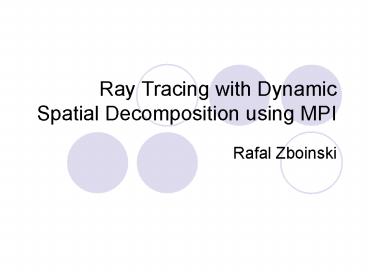Ray Tracing with Dynamic Spatial Decomposition using MPI - PowerPoint PPT Presentation
1 / 18
Title:
Ray Tracing with Dynamic Spatial Decomposition using MPI
Description:
Bump-mapping to produce realistic surfaces. Exploit Parallelism (using MPI) ... Bump Mapping. Motion Blur. Parallel Implementation. Master - Worker Paradigm. Renderer ... – PowerPoint PPT presentation
Number of Views:31
Avg rating:3.0/5.0
Title: Ray Tracing with Dynamic Spatial Decomposition using MPI
1
Ray Tracing with Dynamic Spatial Decomposition
using MPI
- Rafal Zboinski
2
Ray Tracing
- Basic Techniques
- Phong Shading Model
- Diffuse, Specular
- Reflection
- Refraction
- Beers law Percentage of light transmitted T
e-(edc) - (e absorbity, d distance, c
concentration/density) - Advanced Ray Tracing Techniques
- Shoot out multiple rays to produce more realistic
effects - Soft Shadows using spherical area light sources
- Motion Blur to produce realistic
animation/movies - Texture Mapping
- Bi-linear interpolation to smooth textures
- Bump-mapping to produce realistic surfaces
- Exploit Parallelism (using MPI)
- Embarrassingly Parallel
- Dynamically decompose scene into chunks of
optimal size to render movies on lots of CPUs
3
Basic Ray Tracer
4
Textures
5
Soft Shadows
6
Bump Mapping
7
Motion Blur
8
Parallel Implementation
9
Master - Worker Paradigm
- Renderer
- Basic Renderer for a one CPU implementation (No
MPI) - Handles both ray tracing and 2D output
- RendererMaster
- Only handles 2D and manages workers
- Doesnt touch ray tracing
- RendererWorker
- Only handles ray tracing computation doesnt
know about windows, X, etc.
Renderer
RendererMaster
RendererWorker
10
Algorithm Overview
Processing (hard to compute)
t 1
Current Frame
Ahead of the game
t 2
Overflow Frame
11
Problems
- We dont have to wait on CPUs to finish but..
- Very small grid sizes with lots of CPUs require
many overflow buffers - approx buffers Processors/(Grids per frame)
- Only used 2 buffers
- Even worse when there is a complex data/slow
nodes
Computationally Complex Nodes
Slow nodes
T 3
T 4
T 1
12
Problem Pictures
13
Grid Size and Effect on Performance
- Very fine grid causes increased bandwidth
requirements - Goal Adapt grid size to optimize performance
- Single Processor Times
- 8x8 Grid 11.8302 sec/frame
- 16x16 Grid 14.693 sec/frame
14
8x8 Grid, 512x512 - Rohan
15
16x16 Grid, 512x512 - Rohan
16
Future Work
- Use more overflow buffers to prevent overwriting
but.. - Attempt to load-balance per frame to prevent
skipping ahead
17
Movies and Questions
18
Movies and Questions






























